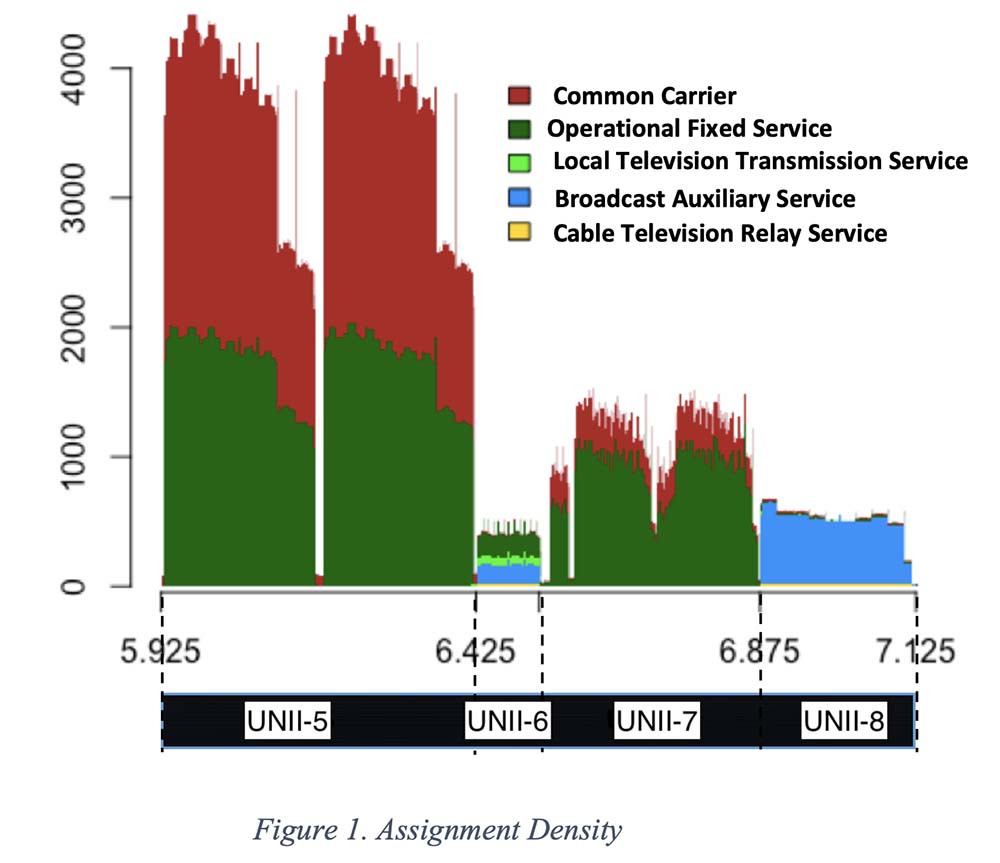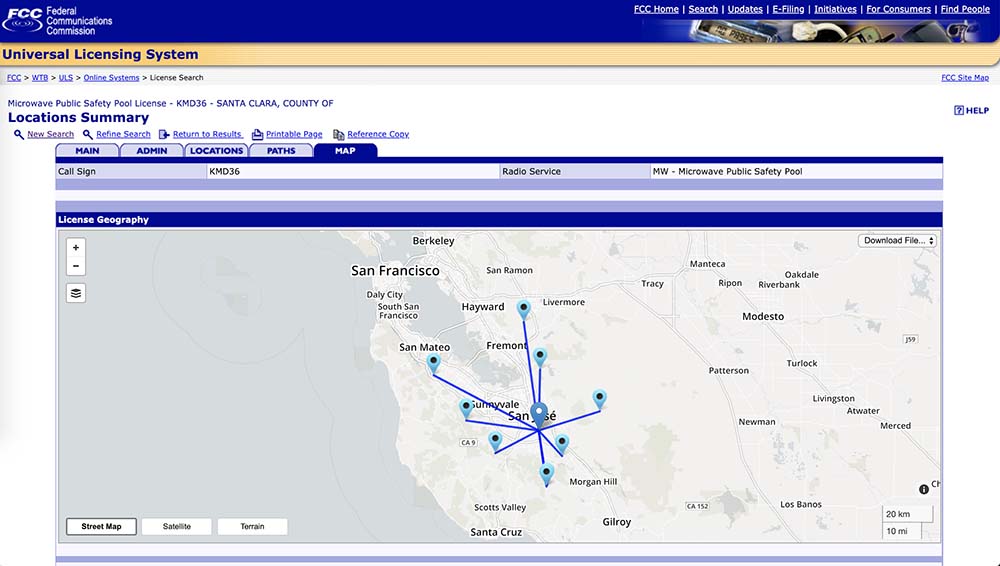In this installment of getting to know Wi-Fi 6E, we’ll focus on the incumbents who occupy the 6 GHz spectrum and the measures being taken to protect them, if any, as the frequency band transitions to allow unlicensed use – including a system underdevelopment called automated frequency control (AFC).
As of the writing of this blog, the United States is the only country who has opened the 6 GHz band for unlicensed use, while respective European countries expect to allow similar unlicensed use by early 2021. When we say 6 GHz spectrum, in the US, we are specifically referring to UNII bands 5, 6, 7, and 8, which amounts to a massive 1200 MHz of spectrum from 5925 MHz to 7125 MHz.
The Incumbents
Let’s take a look at the incumbents in the 6 GHz spectrum
| Band | Allowed Unlicensed Usage | Incumbents |
|---|---|---|
| UNII-5 | Low Power Indoor | Fixed Service, Satellite Service |
| UNII-6 | Low Power Indoor, Standard Power AP | Satellite Service, TV and Broadcast Services |
| UNII-7 | Low Power Indoor | Fixed Service, Satellite Service |
| UNII-8 | Low Power Indoor, Standard Power AP | Satellite Service, TV and Broadcast Services |
- Fixed Service
- By far the heaviest user group of 6 GHz, usually in the form of fixed microwave links. There are nearly 50,000 registered 6 GHz microwave links in the US. Most links are in the UNII-5 band, followed by UNII-7. Microwave links aren’t as common in UNII-8, but they do exist. Fixed microwave links are not allowed in UNII-6 as to prevent overlap with television and broadcast services.
- These links are used for a sorts of private and common carrier purposes, such as control and management of public utilities, public safety uses (backhaul for emergency and police dispatch), backhaul for cell towers, long distance telephone links, and many more. Microwave links are regarded as extremely reliable and some are designed to allow less than 30 seconds of downtime in a year. That’s 99.999% to 99.9999% reliability.
- Satellite Service
- Fixed Earth-to-Space. Allowed across UNII-5 through UNII-8, except the upper 150 MHz of UNII-8. Most heavily utilizes UNII-5. Part of the “conventional c-band.” Common uses include TV and Radio uplink for distribution and backhaul for voice and data communications.
- Mobile Space-to-Earth satellite links in portions of UNII-7 and UNII-8.
- Television and Broadcast Services
- Usage in UNII-6 and UNII-8. Wide range of uses related to transmission and relay of video signals, and electronic news gathering (think local news TV truck with the mast that raises) for broadcast and cable TV entities.
- Use is also granted in the lower part of UNII-8 for special large scale audio usage by broadcast entities, venue and sounds production companies.
- Existing unlicensed use – Ultra Wide Band across UNII-5, 6, 7, and 8.
- Ultra Wide Band had previously been allowed unlicensed use of 6 GHz, which doesn’t change
To give an idea of what is out there from a licensed usage perspective, here’s the number and types of active licenses across UNII 5, 6, 7, and 8, except satellite.

Source: https://docs.fcc.gov/public/attachments/FCC-18-147A1_Rcd.pdf
Protecting the Incumbents
The FCC’s vision for unlicensed use in 6 GHz was to maximize unlicensed usage, while protecting incumbents from harmful interference. To protect incumbents, two modes of operation have been devised; lower power operations, and standard power operations.
Low Power Operations
Don’t be fooled by the name, Low Power mode is intended for general use and intended to meet most home and enterprise use cases. Low Power Mode is allowed across the entire 1200 MHz of the 6 GHz spectrum. The idea is that by enacting the following restrictions, interference to incumbents will be impossible:
- Limiting low power mode APs to a power spectral density of 5 dBm/MHz and -1 dBm/MHz for client devices
- Require use a contention based protocol
- Operate indoors only – APs will be labeled “FCC regulations restrict to indoor use only”
- With integrated antennas only
- Disallowing weatherizing low power APs
- And disallowing battery powered APs,
As of this writing, there is still the possibility of increasing allowed output to 8 dBm/MHz Power Spectral Density (PSD) through a Further Notice of Proposed Rule Making. With the constant PSD, the EIRP doubles with channel bandwidth. So we will actually have the highest allowed EIRP with wider bandwidth. EIRP is 18 dBm at 20 MHz, 21 dBm at 40 MHz, and 24 dBm at 80 MHz. 18-24 dBm EIRP is well within the typical range for enterprise APs.
Standard Power Operations
Standard Power usage removes many of the restrictions of Low Power mode, such as allowing indoor and outdoor usage, and the use of connectorized external antennas. Standard Power use is limited to UNII-5 and UNII-7, which is about 800 MHz of the available spectrum, and follows similar EIRP limits as 5 GHz/UNII-1 and UNII-3 of 36 dBm max EIRP or 23 dBm/MHz PSD. However, usage in standard power mode is gated by an automated frequency control system. Where an access point must register its location to a central database, which looks at nearby licensed usage and returns allowed frequencies and output power to the APs. The AFC system is specifically meant to protect the tens of thousands of fixed microwave links across the US from potential harmful interference. As for satellite links, which also share these subbands, the FCC explicitly stated due to the relatively low power of unlicensed devices, there is little to no risk causing harmful interference to 6 GHz satellite services. Standard Power operations are not allowed in UNII-6 or UNII-8 because the FCC felt since most of the incumbents in these sub-bands are mobile, the use of an AFC system would not be practical. There is one protection built in for satellite service and that is setting a limit of Limit of 21 dBm EIRP above 30 degree elevation angle, similar to existing UNII-1 restrictions.
Automated Frequency Control (AFC)
To reduce potential harmful interference to incumbent licensed users, the FCC is requiring the use of an automated frequency control system (AFC) for Standard Power operations. There is precedent for utilizing frequency control systems. Other spectrum bands are already utilizing such systems, for example the TV White Spaces uses White Space Database Administration and the recently lighty-licensed CBRS uses Spectrum Access Service. However, AFC in 6 GHz will be the first time such a system has gone “mainstream.”
The way it works is an access point, or more probably a central control point such as a cloud management system or on-prem controller acting as proxy for APs under control will send the geolocation, including location confidence, antenna height, FCC ID and device serial number to an AFC operator. The AFC will do a lookup in the FCC Universal Licensing System (ULS) and calculate the ratio of interference to noise power (I/N) using one of several attenuation models based on the distance from the licensed antenna. The AFC checks that I/N is less than -6 for ch-channel and adjacent channels, and then returns a list of allowable frequencies and output powers, for which the Wi-Fi AP, based on the list, can choose its operating channel and power. Standard Power APs must check in with the AFC once a day, and are allowed to operate until 11:59pm the following day without a check in.
If you’re curious, the models used to calculate I/N varies based on distance. For short distances, less than 30m, a simple free-space model will be used. For medium distances of 30m-1km, the WINNER II model will be used. And finally for longer distances of 1km to 2000km the Irregular Terrain Model is mandated.
The FCC’s universal licensing system is generally the source of data for the AFC operators, except in a few scenarios. First, the FCC is taking all practical steps to protect radio astronomy from 6650-6675 MHz, so the AFCs will include exclusion zones near observatories. Second, the ULS does not have information about microwave links near the borders of Canada and Mexico. So, that information will be included into the AFC from separate sources.
AFC operators are yet to be approved by the FCC. In all likelihood, operators will not be approved until late 2020, early 2021, which means Standard Power APs will not be allowed until we have AFC operators. It is expected there will be several AFC operators. These operators are allowed to charge a fee for use of the service.
If you’re curious if there are microwave links in your vicinity, you can look them up yourself in the FCC’s Universal Licensing System. The geosearch is quite handy. We’ve had the most success searching by state and county and filtering on active licences between 5925 MHz to 7125 MHz. Each license includes detailed information about the link, including a map of the transmitters and receivers. For example, there are 205 microwave links in Santa Clara county alone, where Mist is headquartered. Here’s one such point-to-multipoint link.
